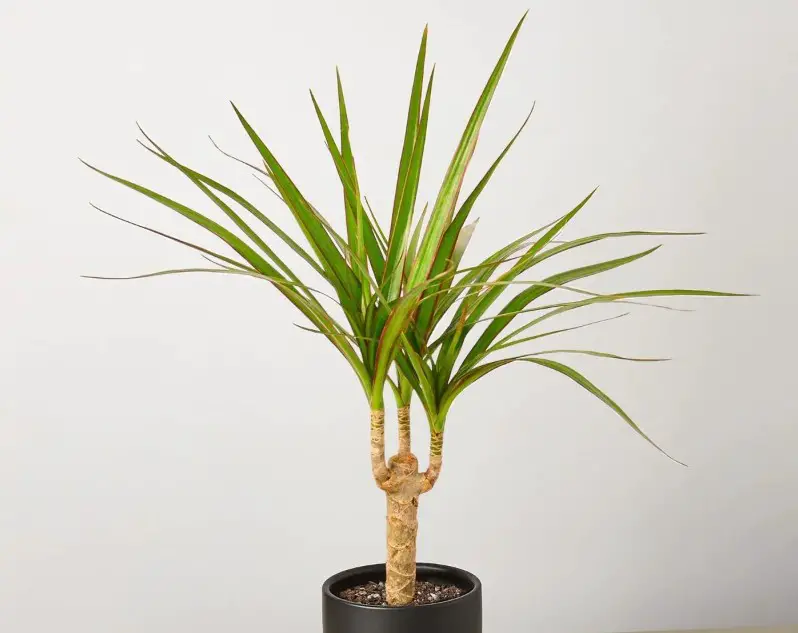Dracaena marginata, commonly known as the Dragon Tree, is an elegant and resilient indoor plant that has captivated the hearts of plant enthusiasts around the globe. With its striking green leaves edged in red, the Dragon Tree not only serves as a beautiful addition to any home decor but also thrives in a variety of conditions, making it an ideal choice for both novice and experienced gardeners.
This comprehensive guide will delve into the specifics of Dracaena marginata care, covering everything from optimal growing conditions to common pests, all while ensuring your plant flourishes beautifully in your space.
Overview of Dracaena Marginata

Botanical Characteristics
- Common Names: Dragon Tree, Madagascar Dragon Tree, Dragon Plant
- Scientific Name: Dracaena marginata
- Family: Asparagaceae
- Plant Type: Broadleaf evergreen
- Native Habitat: Originally from Madagascar, where it grows in tropical forests.
- Mature Size: In its natural environment, the Dragon Tree can reach heights of 15 to 20 feet, but when cultivated as a houseplant, it is typically pruned to 6 feet or less for ease of maintenance.
Key Features
The Dragon Tree is renowned for its:
- Distinctive Appearance: Long, sword-like leaves that emerge from tall, slender stems.
- Color Variations: Leaves are predominantly green with striking red edges, providing a stunning visual contrast.
- Air Purifying Qualities: Known to improve indoor air quality by filtering out toxins, making it a popular choice for homes and offices.
Toxicity Warning
It’s essential to note that Dracaena marginata is toxic to pets (dogs and cats) if ingested. Therefore, it’s crucial to keep this plant out of reach of curious animals.
Ideal Growing Conditions for Dracaena Marginata
Light Requirements
Dracaena marginata thrives in bright, indirect sunlight. Here’s how to ensure it gets the right light:
- Optimal Location: Position your plant near a window that receives filtered light or in a room with ample natural light.
- Avoid Direct Sunlight: Direct exposure to sunlight can scorch the leaves, leading to unsightly brown spots. If your plant starts showing signs of leaf burn, consider moving it to a shadier spot.
- Adaptability: While it prefers bright conditions, the Dragon Tree can also tolerate partial shade, making it versatile for various indoor environments.
Soil Preferences
The type of soil you use can significantly impact the health of your Dragon Tree:
- Soil Type: Choose a loamy, well-draining potting mix. A mixture that includes peat moss and perlite or sand is ideal as it retains moisture while allowing excess water to drain.
- pH Levels: The optimal soil pH for Dracaena marginata is between 6.0 and 6.5 (neutral to slightly acidic). This range supports nutrient availability and promotes healthy growth.
Watering Needs
Watering correctly is crucial for the health of your Dragon Tree:
- Watering Frequency: Allow the top 2 to 3 inches of soil to dry out before watering. Depending on humidity and temperature, this may mean watering every 2 to 3 weeks.
- Signs of Overwatering: Yellowing leaves or a mushy stem can indicate overwatering. Always ensure your pot has adequate drainage holes to prevent water from pooling.
- Signs of Underwatering: If the leaves appear wilted or crispy, your Dragon Tree may be thirsty.
Temperature and Humidity
- Ideal Temperature: Dracaena marginata prefers warm conditions, thriving in temperatures between 70°F and 80°F. It is sensitive to cold drafts, so avoid placing it near air conditioning vents or drafty windows.
- Humidity Levels: Regular household humidity levels are generally acceptable, but if your home is particularly dry (especially in winter), consider increasing humidity around your plant. Misting the leaves or using a pebble tray filled with water can help maintain optimal humidity.
Fertilizing Your Dracaena Marginata
Fertilization is essential for promoting healthy growth, especially during the growing season:
- Type of Fertilizer: Use a balanced, controlled-release liquid fertilizer. Look for fertilizers with an N-P-K ratio of 10-10-10 or similar.
- Application Timing: Fertilize your Dragon Tree at the beginning of spring when it begins to show new growth.
- Frequency: Generally, fertilizing every 4 to 6 weeks during the growing season (spring and summer) is sufficient. Reduce feeding in fall and winter when the plant’s growth slows down.
Types of Dracaena Marginata
There are several varieties of Dracaena marginata that can add a unique flair to your indoor garden:
- Dracaena marginata ‘Tricolor’: Characterized by its dark red edges and green leaves with a creamy stripe running down the center, this variety is a favorite for its dramatic appearance.
- D. marginata ‘Colorama’: This cultivar features bright pink and green variegation and requires ample light to maintain its vibrant colors.
- D. marginata ‘Bicolor’: This variety showcases leaves with alternating red and green stripes, offering a stunning visual contrast.
Pruning and Maintenance Tips
Pruning Techniques
Regular pruning keeps your Dragon Tree looking its best and encourages bushier growth:
- Removing Dead Leaves: It’s natural for a Dragon Tree to shed its older leaves. Simply remove any yellow or brown leaves to keep the plant tidy.
- Trimming Back: To maintain the desired height and shape, trim back long stems with sterilized pruning shears. Make sure to cut just above a leaf node to encourage new growth.
Propagating Your Dragon Tree
Propagating Dracaena marginata is simple and rewarding:
- Stem Cuttings: In spring, cut a stem about 8 inches long. Remove any lower leaves to expose the stem.
- Rooting the Cutting: Place the cutting in a glass of water or directly into moist potting soil. Ensure it receives bright, indirect light.
- Root Development: In about three weeks, roots should begin to develop, at which point you can care for it like a mature plant.
Potting and Repotting
Recognizing When to Repot
Check your Dragon Tree annually for signs it needs repotting:
- Signs of Being Root Bound: Look for roots growing out of the drainage holes or a lack of new growth, indicating it’s time for a larger pot.
- Choosing a New Pot: Select a new pot that is 2 inches larger in diameter than the current one and has drainage holes.
- Repotting Frequency: Due to their slow growth, Dragon Trees typically need repotting every 2 to 3 years. However, refreshing the potting soil annually can help provide fresh nutrients.
Common Pests and Problems
Pest Management
While generally disease-resistant, Dracaena marginata can be affected by several pests:
- Common Pests: Watch for scale insects, mealybugs, and spider mites. Mealybugs are particularly identifiable by their cottony appearance and sticky residue.
- Treatment Options: Use neem oil, insecticidal soap, or horticultural oil to treat infestations. Spray on the affected areas of the plant and the surrounding soil as necessary.
Identifying Common Problems
Here are some common issues to watch out for with your Dragon Tree:
- Leaves Falling Off: This often indicates overwatering. Monitor your watering schedule and ensure the soil dries out adequately between waterings.
- Drooping Leaves: Drooping can indicate that the plant is thirsty or suffering from root rot. Adjust your watering frequency accordingly.
- Brown Leaf Tips: Brown tips may suggest low humidity or inconsistent watering. Increase humidity and maintain a steady watering schedule to remedy this.
- Crispy Leaves: If leaves become crunchy, this is typically a sign of too much direct sunlight. Relocate the plant to an area with filtered light.
- Yellowing Leaves: This can be caused by too much direct sun or improper watering. Adjust the plant’s location and check your watering practices to find a balance.
Tips for Successful Dragon Tree Care
- Regularly Inspect for Pests: Conduct routine checks for pests or signs of distress to catch issues early.
- Use Appropriate Water: To prevent fluoride build-up, use distilled or rainwater for your Dragon Tree.
- Adjust Humidity: If your home is particularly dry, consider using a humidifier or placing your plant on a pebble tray to maintain moisture levels.
- Rotate Your Plant: Occasionally rotate your Dragon Tree to ensure even light exposure and prevent it from leaning towards the light source.
Conclusion
Caring for a Dracaena marginata, or Dragon Tree, can be a deeply rewarding experience, transforming your living space with its striking appearance while providing you with an easy-to-maintain houseplant. By adhering to the guidelines laid out in this comprehensive care guide, you can cultivate a healthy and vibrant Dragon Tree that thrives in your home. Enjoy the unique beauty and air-purifying benefits of this fantastic plant while enhancing your indoor environment!






